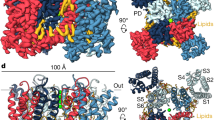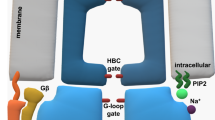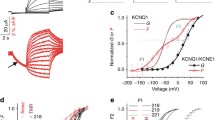Abstract
The kinetics of voltage-dependent inactivation of the rapidly activating delayed rectifier, I Kr, are unique among K+ channels. The human ether-a-gogo-related gene (HERG) encodes the pore-forming subunit of I Kr and shares a high degree of homology with ether-a-gogo (EAG) channels that do not inactivate. Within those segments thought to contribute to the channel pore, HERG, possesses several serine residues that are not present in EAG channels. Two of these serines, S620 and S631, are known to be required for inactivation. We now show that a third serine, S641, which resides in the outer portion of the sixth transmembrane segment, is also critical for normal inactivation. As with the other serines, S641 is also involved in maintaining ion selectivity of the HERG channel and alters sensitivity to block by E4031. Larger charged or polar substitutions (S641D and S641T) disrupted C-type inactivation in HERG. Smaller aliphatic and more conservative substitutions (S641A and S641C) facilitated C-type inactivation. Our data show that, like S620 and S631, S641 is another key residue for the rapid inactivation. The altered inactivation of mutations at S620, S631, and S641 were dominant, suggesting that a network of hydroxyl side chains is required for the unique inactivation, permeation, and rectification of HERG channels.
Similar content being viewed by others
References
Sanguinetti, M. C. and Jurkiewicz, N. K. (1991) Delayed rectifier outward K+ current is composed of two currents in guinea pig atria cells. Am. J. Physiol. 260, H393-H399.
Sanguinetti, M. C., Jiang, C., Curran, M. E., et al. (1995) A mechanistic link between an inherited and an acquired cardiac arrhythmia: HERG encodes the IKr potassium channel. Cell 81, 299–307.
Trudeau, M. C., Warmke, J. W., Ganetzky, B., et al. (1995) HERG, a human inward rectifier in the voltage-gated potassium channel family. Science 269, 92–95.
Curran, M. E., Splawski, I., Timothy, K. M., et al. (1995) A molecular basis for cardiac arrhythmia: HERG mutations cause long QT syndrome. Cell 80, 795–803.
Tseng, G. N. (2001) I(Kr): the hERG channel. J. Mol. Cell. Cardiol. 33, 835–849.
Sanguinetti, M. C. and Jurkiewicz, N. K. (1990) Two components of the delayed rectifier K+ current: differential sensitivity to block by class III antiarrhythmic agents. J. Gen. Physiol. 96, 195–215.
Rock, K. L., Gramm, L., Rothstein, L., et al. (1994) Inhibitors of the proteasome block the degradation of most cell proteins and the generation of peptides presented on MHC class I molecules. Cell 78, 761–771.
Smith, P. L., Baukrowitz, T., and Yellen, G. (1996) The inward rectification mechanism of the HERG cardiac potassium channel. Nature 379, 833–836.
Liu, D. T., Tibbs, G. R., and Siegelbaum, S. A. (1996) Subunit stoichiometry of cyclic nucleotide-gated channels and effects of subunit order on channel function. Neuron 16, 983–990.
Spector, P. S., Curran, M. E., Zou, A., et al. (1996) Fast inactivation causes rectification of the IKr channel. J. Gen. Physiol. 107, 611–619.
Hoshi, T., Zagotta, W. N., and Aldrich, R. W. (1991) Two types of inactivation in Shaker K+ channels: effects of alterations in the carboxyterminal region. Neuron 7, 547–556.
Hoshi, T., Zagotta, W. N., and Aldrich, R. W. (1990) Biophysical and molecular mechanisms of Shaker potassium channel inactivation. Science 250, 533–538.
Demo, S. D., and Yellen, G. (1991) The inactivation gate of the Shaker K+ channel behaves like an open-channel blocker. Neuron 7, 743–753.
Choi, K. L., Aldrich, R. W., and Yellen, G. (1991) Tetraethylammonium blockade distinguishes two inactivation mechanisms in voltage-activated K+ channels. Proc. Natl. Acad. Sci. USA 88, 5092–5095.
Heginbotham, L. and MacKinnon, R. (1992) The aromatic binding site for tetraethylammonium ion on potassium channels. Neuron 8, 483–491.
Panyi, G., Sheng, Z., and Deutsch, C. (1995) C-type inactivation of a voltage-gated K+ channel occurs by a cooperative mechanism. Biophys. J. 69, 896–903.
Schonherr, R. and Heinemann, S. H. (1996) Molecular determinants for activation and inactivation of HERG, a human inward rectifier potassium channel. J. Physiol. (Lond.) 493, 635–642.
Warmke, J., Drysdate, R., and Ganetzky, B. (1991) A distinct potassium channel polypeptide encoded by the Drosophila eag locus. Science 252, 1560–1562.
Robertson, G. A., Warmke, J. M., and Ganetzky, B. (1996) Potassium currents expressed from Drosophila and mouse eag cDNAs in Xenopus oocytes. Neuropharmacology 35, 841–850.
Herzberg, I. M., Trudeau, M. C., and Robertson, G. A. (1998) Transfer of rapid inactivation and sensitivity to the class III antiarrhythmic drug E-4031 from HERG to M-eag channels. J. Physiol. 511, 3–14.
Ficker, E., Jarolimek, W., Kiehn, J., et al. (1998) Molecular determinants of dofetilide block of HERG K+ channels. Circ. Res. 82, 386–395.
Ulens, C. and Tytgat, J. (2000) Redox state dependency of HERGS631C channel pharmacology: relation to C-type inactivation. FEBS Lett. 474, 111–115.
Zou, A., Xu, Q. P., and Sanguinetti, M. C. (1998) A mutation in the pore region of HERG K+ channels expressed in Xenopus oocytes reduces rectification by shifting the voltage dependence of inactivation. J. Physiol. (Lond.) 509, 129–137.
Fan, J. S., Jiang, M., Dun, W., et al. (1999) Effects of outer mouth mutations on hERG channel function: a comparison with similar mutations in the Shaker channel. Biophys. J. 76, 3128–3140.
Cui, J., Melman, Y., Palma, E., et al. (2000) Cyclic AMP regulates the HERG K(+) channel by dual pathways. Curr. Biol. 10, 671–674.
Kagan, A., Yu, Z., Fishman, G. I., et al. (2000) The dominant negative LQT2 mutation A561V reduces wild-type HERG expression. J. Biol. Chem. 275, 11,241–11,248.
Bian, J., Cui, J., and McDonald, T. V. (2001) HERG K(+) channel activity is regulated by changes in phosphatidyl inositol 4,5-bisphosphate. Circ. Res. 89, 1168–1176.
Jurkiewicz, N. K. and Sanguinetti, M. C. (1993) Rate-dependent prolongation of cardiac action potentials by a methanesulfonanilide class III antiarrhythmic agent. Circ. Res. 72, 75–83.
Kiehn, J., Lacerda, A. E., Wible, B., et al. (1996) Molecular physiology and pharmacology of HERG. Single-channel currents and block by dofetilide. Circulation 94, 2572–2579.
Spector, P. S., Curran, M. E., Keating, M. T., et al. (1996) Class III antiarrhythmic drugs block HERG, a human cardiac delayed rectifier K+ channel. Open-channel block by methanesulfonanilides. Circ. Res. 78, 499–503.
Lees-Miller, J. P., Duan, Y., Teng, G. Q., et al. (2000) Novel gain-of-function mechanism in K(+) channel-related long-QT syndrome: altered gating and selectivity in the HERG1 N629D mutant [see comments]. Cir.c Res. 86, 507–513.
Mitcheson, J. S., Chen, J., and Sanguinetti, M. C. (2000) Trapping of a methanesulfonanilide by closure of the HERG potassium channel activation gate. J. Gen. Physiol. 115, 229–240.
Wang, S., Morales, M. J., Liu, S., et al. (1997) Modulation of HERG affinity for E-4031 by [K+]o and C-type inactivation. FEBS Lett. 417, 43–47.
Ficker, E., Jarolimek, W., and Brown, A. M. (2001) Molecular determinants of inactivation and dofetilide block in ether a-go-go (EAG) channels and EAG-related K(+) channels. Mol. Pharmacol. 60, 1343–1348.
Liu, J., Zhang, M., Jiang, M., et al. (2002) Structural and functional role of the extracellular s5-p linker in the HERG potassium channel. J. Gen. Physiol. 120, 723–737.
Kiss, L., LoTurco, J., and Korn, S. J. (1999) Contribution of the selectivity filter to inactivation in potassium channels. Biophys. J. 76, 253–263.
Starkus, J. G., Kuschel, L., Rayner, M. D., et al. (1997) Ion conduction through C-type inactivated Shaker channels. J. Gen. Physiol., 110, 539–550.
Ogielska, E. M., Zagotta, W. N., Hoshi, T., et al. (1995) Cooperative subunit interactions in C-type inactivation of K channels. Biophys. J. 69, 2449–2457.
Liu, Y., Jurman, M. E., and Yellen, G. (1996) Dynamic rearrangement of the outer mouth of a K+ channel during gating. Neuron 16, 859–867.
Yellen, G., Sodickson, D., Chen, T. Y., et al. (1994) An engineered cysteine in the external mouth of a K+ channel allows inactivation to be modulated by metal binding. Biophys. J. 66, 1068–1075.
Author information
Authors and Affiliations
Corresponding author
Rights and permissions
About this article
Cite this article
Bian, JS., Cui, J., Melman, Y. et al. S641 contributes HERG K+ channel inactivation. Cell Biochem Biophys 41, 25–39 (2004). https://doi.org/10.1385/CBB:41:1:025
Issue Date:
DOI: https://doi.org/10.1385/CBB:41:1:025




